Sewer pipes and fittings: choice and application
Properly selected and correctly installed sewage pipes and fittings are an integral part of any wastewater disposal system. In this article we will consider the main types of pipes and fittings used in the construction of individual housing construction objects. We will also tell about the distinctive advantages and disadvantages of modifications presented on the market.
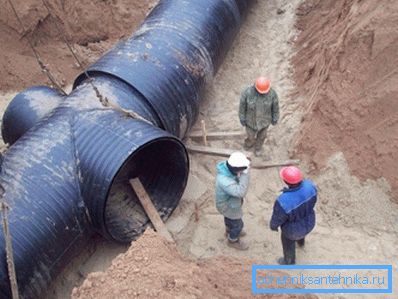
Main varieties
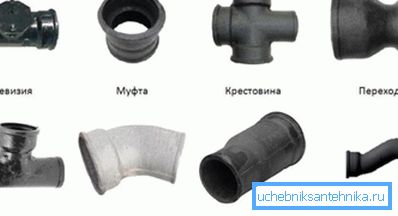
Modern pipes and fittings for sewage, in accordance with the materials used in their manufacture, are divided into the following types:
- metal (cast iron and steel modifications);
- polymeric;
- concrete and asbestos cement;
- ceramic.
A detailed description of all these varieties can be found in the relevant articles presented on our portal. Since we decided to consider the features of the device of domestic sewage systems, we will focus on the description of the most popular polymer pipes and fittings today.
Reasons for choosing polymer systems
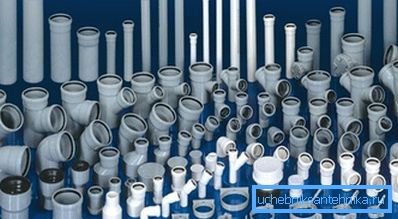
Sewage, regardless of modification, is a system through which transportation of corrosive media with active chemical processes is carried out. Of course, the impact of aggressive media adversely affects the state of cast iron or other ferrous metals.
Thus, the statements of manufacturers of cast-iron fittings and pipes, which speak of a guaranteed hundred-year resource, do not correspond to reality.
Important: Metal systems are destroyed an order of magnitude earlier, acquiring internal reliefs, in which various deposits accumulate, contributing to the formation of blockage.
At the same time, the dimensions of sewage pipes and fittings made of ceramic or concrete are not suitable for assembling household systems designed to service a country house.
So, there are polymeric products that are resistant to aggressive media and are represented by a wide range of sizes and configurations. That is why, let's take a closer look at what are the pipes and fittings for plastic sewer pipes.
The advantages of using polymer components
Among the advantages of using polymer pipes and fittings, we note the following:
- reasonable price in comparison with the cost of metal counterparts;
- low weight and, as a result, ease of installation;
- long operational resource over 50 years without blockage;
- absolute corrosion resistance;
- ideally smooth internal surface and, as a result, zero degree of sedimentation of pollution;
- absolute resistance to aggressive environments;
- slight condensation in comparison with metal counterparts, where the condensate is much more.
Types of plastic pipes and fittings

In accordance with the used production material, polymer products used for the construction of domestic internal and external sewer systems, there are three types:
- polyethylene (PE) modifications;
- polypropylene (PP) modifications;
- polyvinyl chloride (PVC) modifications.
According to the assembly method, the following connection types are distinguished:
- socket connection;
- welded joint type;
- Coupling with sliding couplings.
In accordance with the installation site, pipes and fittings are subdivided into:
- modifications intended for internal installation;
- modifications intended for external installation.
Modern polymer pipes and fittings can be used in the construction of the following types of sewer systems:
- Systems designed to discharge continuously flowing wastewater with an average temperature above + 80? С;
- The systems intended for removal of periodically arriving sewage with an average temperature over + 95?
- Systems designed for the disposal of chemically active wastewater with a pH level of 2-12.
Varieties of PVC sewer fittings
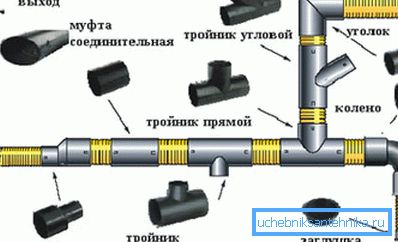
The fittings equipped with rubber rings for PVC sewer pipes are divided into the following categories:
- Couplings - used to connect in a straight section of two pipes;
- Reduction - is an adapter, through which you can combine pipes with different cross-sectional diameter;
- Tee (45, 67, 90 degrees) - used for removal of pipes from the pipeline at an appropriate angle;
- Audit - it is used for prophylactic cleaning of the pipeline, and therefore it is installed in areas with an increased probability of blockage;
- Cap - used to ensure the tightness of the end point of the pipeline;
- Crosses at 45 and 90 degrees are one-or two-plane structures through which complex connecting nodes are assembled;
- Taps - are used when performing turns of the pipeline;
- Check valves - is a type of fitting that prevents the return flow of wastewater through the pipeline.
Installation of structural elements in a single system
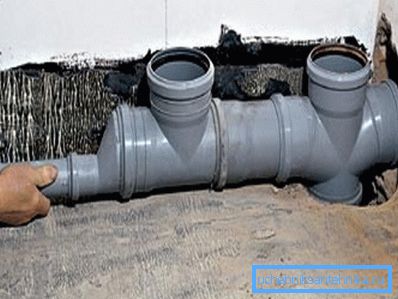
After we have decided on the peculiarities of the types of sewage pipes and fittings on the market, we will look at the installation instructions.
Connection of bell-shaped type on PVC products does not differ in special complexity, and will be executed as follows:
- We check the presence of the seal in the socket and make sure that the ring is not twisted;
- The narrow end of the product is inserted into the socket and, occasionally turning it, we advance deep into it;
- Having reached the stop, we take the product 2-5 mm back and thus create a compensation gap in case of thermal expansion.
Tip: To make the installation more efficient, the pipe can be oiled with soapy water.
Welded connection, as a rule, is carried out on sewage areas with an external location. To perform the installation in this case, you need special welding equipment.
Starting to install the fitting, you need to remember that the weld, as opposed to socket, is rigid. Therefore, immediately it is necessary to correctly determine the position of the installed elements.
Conclusion
Now you have a general idea of what types of pipes and fittings can be used when constructing a domestic sewage system, and what is their installation instructions.
There are questions that need clarification? In this case, more useful information can be found by watching the video in this article.